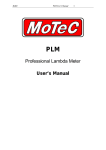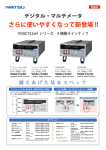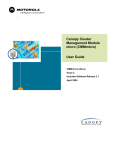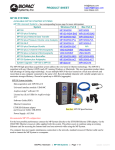Download CAT5 Audio/Video Splitters (2-Channel Hub, 4-Channel
Transcript
AC150A-2 AC150A-4 AC151A-REM DECEMBER 2001 AC150AE-2 AC150AE-4 AC151AE-REM CAT5 Audio/Video Splitters (2-Channel Hub, 4-Channel Hub, and Remote) CUSTOMER SUPPORT INFORMATION Order toll-free in the U.S.: Call 877-877-BBOX (outside U.S. call 724-746-5500) FREE technical support 24 hours a day, 7 days a week: Call 724-746-5500 or fax 724-746-0746 Mailing address: Black Box Corporation, 1000 Park Drive, Lawrence, PA 15055-1018 Web site: www.blackbox.com • E-mail: [email protected] FCC/IC RFI STATEMENTS, EU DECLARATION OF CONFORMITY FEDERAL COMMUNICATIONS COMMISSION AND INDUSTRY CANADA RADIO-FREQUENCY INTERFERENCE STATEMENTS This equipment generates, uses, and can radiate radio-frequency energy and if not installed and used properly, that is, in strict accordance with the manufacturer’s instructions, may cause interference to radio communication. It has been tested and found to comply with the limits for a Class A computing device in accordance with the specifications in Subpart B of Part 15 of FCC rules, which are designed to provide reasonable protection against such interference when the equipment is operated in a commercial environment. Operation of this equipment in a residential area is likely to cause interference, in which case the user at his own expense will be required to take whatever measures may be necessary to correct the interference. Changes or modifications not expressly approved by the party responsible for compliance could void the user’s authority to operate the equipment. This digital apparatus does not exceed the Class A limits for radio noise emission from digital apparatus set out in the Radio Interference Regulation of Industry Canada. Le présent appareil numérique n’émet pas de bruits radioélectriques dépassant les limites applicables aux appareils numériques de la classe A prescrites dans le Règlement sur le brouillage radioélectrique publié par Industrie Canada. EUROPEAN UNION DECLARATION OF CONFORMITY This equipment complies with the requirements of the European EMC Directive 89/336/EEC. 1 CAT5 AUDIO/VIDEO SPLITTERS NORMAS OFICIALES MEXICANAS (NOM) ELECTRICAL SAFETY STATEMENT INSTRUCCIONES DE SEGURIDAD 1. Todas las instrucciones de seguridad y operación deberán ser leídas antes de que el aparato eléctrico sea operado. 2. Las instrucciones de seguridad y operación deberán ser guardadas para referencia futura. 3. Todas las advertencias en el aparato eléctrico y en sus instrucciones de operación deben ser respetadas. 4. Todas las instrucciones de operación y uso deben ser seguidas. 5. El aparato eléctrico no deberá ser usado cerca del agua—por ejemplo, cerca de la tina de baño, lavabo, sótano mojado o cerca de una alberca, etc. 6. El aparato eléctrico debe ser usado únicamente con carritos o pedestales que sean recomendados por el fabricante. 7. El aparato eléctrico debe ser montado a la pared o al techo sólo como sea recomendado por el fabricante. 8. Servicio—El usuario no debe intentar dar servicio al equipo eléctrico más allá a lo descrito en las instrucciones de operación. Todo otro servicio deberá ser referido a personal de servicio calificado. 9. El aparato eléctrico debe ser situado de tal manera que su posición no interfiera su uso. La colocación del aparato eléctrico sobre una cama, sofá, alfombra o superficie similar puede bloquea la ventilación, no se debe colocar en libreros o gabinetes que impidan el flujo de aire por los orificios de ventilación. 10. El equipo eléctrico deber ser situado fuera del alcance de fuentes de calor como radiadores, registros de calor, estufas u otros aparatos (incluyendo amplificadores) que producen calor. 11. El aparato eléctrico deberá ser connectado a una fuente de poder sólo del tipo descrito en el instructivo de operación, o como se indique en el aparato. 2 NOM STATEMENT, TRADEMARKS 12. Precaución debe ser tomada de tal manera que la tierra fisica y la polarización del equipo no sea eliminada. 13. Los cables de la fuente de poder deben ser guiados de tal manera que no sean pisados ni pellizcados por objetos colocados sobre o contra ellos, poniendo particular atención a los contactos y receptáculos donde salen del aparato. 14. El equipo eléctrico debe ser limpiado únicamente de acuerdo a las recomendaciones del fabricante. 15. En caso de existir, una antena externa deberá ser localizada lejos de las lineas de energia. 16. El cable de corriente deberá ser desconectado del cuando el equipo no sea usado por un largo periodo de tiempo. 17. Cuidado debe ser tomado de tal manera que objectos liquidos no sean derramados sobre la cubierta u orificios de ventilación. 18. Servicio por personal calificado deberá ser provisto cuando: A: El cable de poder o el contacto ha sido dañado; u B: Objectos han caído o líquido ha sido derramado dentro del aparato; o C: El aparato ha sido expuesto a la lluvia; o D: El aparato parece no operar normalmente o muestra un cambio en su desempeño; o E: El aparato ha sido tirado o su cubierta ha sido dañada. TRADEMARKS USED IN THIS MANUAL BLACK BOX and the Corporation. logo are registered trademarks of Black Box Windows is a registered trademark of Microsoft Corporation. Any other trademarks mentioned in this manual are acknowledged to be the property of the trademark owners. 3 CAT5 AUDIO/VIDEO SPLITTERS Contents Chapter Page 1. Specifications ............................................................................................. 5 2. Introduction ............................................................................................... 2.1 Overview .............................................................................................. 2.2 Features ............................................................................................... 2.3 The Complete Package ....................................................................... 2.4 The Splitter Illustrated ....................................................................... 3. Installation ................................................................................................ 3.1 Before You Install .............................................................................. 3.2 Making Connections to the Local Splitter ...................................... 3.3 Making Connections to Each Remote ............................................. 4. Operation ................................................................................................. 13 5. Troubleshooting ...................................................................................... 14 5.1 Calling Black Box .............................................................................. 14 5.2 Shipping and Packaging ................................................................... 14 4 7 7 7 8 9 10 10 10 12 CHAPTER 1: Specifications 1. Specifications Compliance: CE; FCC Part 15 Subpart B Class A, IC Class/classe A Standards: Video: VGA, SVGA, and XGA Interfaces: VGA compatible video, 3.5-mm stereo audio, and a proprietary composite of both of these Video Characteristics: Audio Characteristics: Maximum Distance: Signal: Analog RGB, 0.7 volts peak-to-peak; Impedance: 75 ohms; Horizontal frequencies supported: 30 to 100 kHz; Vertical frequencies (refresh rates) supported: 43 to 100 Hz; Maximum resolution: 1280 x 1024 at 75 Hz; Synchronization: TTL compatible, horizontal and vertical positive/negative sync Frequency response: 20 Hz to 16 kHz (at –3 dB); Signal levels (Vin Vout maximum): 2 volts peak-to-peak 16.4 ft. (5 m) from a Hub or Remote to any attached video or audio device; 360 ft. (110 m) of CAT5 cabling between the Hub and the Remotes User Control: Rear-mounted ON/OFF rocker switch; On Remote only: Rear-mounted screwdial for focus Indicator: Rear-mounted power LED Connectors: On Hubs: (1) HD15 male to the video-source device; (1) HD15 female to the local monitor; (2) 3.5-mm audio jacks: (1) to the audio-source device, (1) to the local speakers or headphones; (1) 4-pin DIN female power inlet; RJ-45 female to Remotes: AC150A(E)-2: (2); AC150A(E)-4: (4); 5 CAT5 AUDIO/VIDEO SPLITTERS Connectors: (continued) Temperature Tolerance: On each Remote: (1) HD15 female to a remote monitor; (1) 3.5-mm audio jack to remote speakers or headphones; (1) 4-pin DIN female power inlet; (1) RJ-45 female to Hub Operating: 32 to 122˚F (0 to 50˚C); Storage: –40 to +158˚F (–40 to +70˚C) Humidity Tolerance: Up to 90% noncondensing at up to 86˚F (30˚C) Enclosure: Steel Power: Input: From utility-power (mains) outlet, through detachable power cord and IEC 320 male inlet, to external transformer: AC150A, AC151A models: 110 VAC at 60 Hz; AC150AE, AC151AE models: 220 VAC at 50 Hz; Output: 9 VAC at 2 amp from transformer to chassis Size: Hubs: 1.2"H x 8.8"W x 3"D (3 x 22.4 x 7.8 cm); Remotes: 1.2"H x 6.2"W x 3"D (3 x 15.7 x 7.8 cm) Weight: Hubs: 1 lb. (0.5 kg); Remotes: 0.6 lb. (0.3 kg) 6 CHAPTER 1: Specifications 2. Introduction 2.1 Overview The CAT5 Audio/Video Splitter simultaneously broadcasts audio and video signals over Category 5 twisted-pair cable to as many as four remote monitors and speakers up to 360 ft. (110 m) away. It consists of a Hub that you’ll connect to your PC or other video- and audio-source device(s), plus up to four Remotes that you’ll place near your monitors, speakers, or other video- and audio-destination device(s). There are four Hub models. The AC150A-2 and AC150AE-2 have two RJ-45 jacks and can send audio and video to two Remotes. The AC150A-4 and AC150AE-4 have four RJ-45 jacks and can send audio and video to as many as four Remotes. There are two Remote models, AC150A-REM and AC150AE-REM. The Hub and Remote models with the “A” infix in their product codes use 110-VAC power; the models with the “AE” infix use 220-VAC power. 2.2 Features • Transmits both audio and video signals between your local and remote locations over CAT5 cable. • Supports cabling distances up to 360 ft. (110 m). • Transparent hardware solution—nothing to configure and no software to run. • Supports high resolution monitors (1280x1024). • Compatible with all major brands of sound cards. • Cascadable. • Picture-focus adjustment at remote sites. 7 CAT5 AUDIO/VIDEO SPLITTERS 2.3 The Complete Package Each Splitter Hub or Remote comes with: • A 110-VAC (“A” models) or 220-VAC (“AE” models) external power-supply transformer. • An input cord for the transformer that’s appropriate for the outlets in your region. • This manual. Each Hub also comes with: • A 6-ft. (1.8-m) HD15 male to HD15 female VGA-extension cable to attach to your video-source device. • A 6-ft. (1.8-m) stereo audio-extension cable with 3.5-mm plugs to attach to your audio-source device. 8 CHAPTER 2: Introduction 2.4 The Splitter Illustrated Figure 2-1 shows a fully installed 4-channel Splitter system. Splitter Remote Remote speakers Splitter Remote CAT5 STP Cables Local speakers Local monitor Remote monitors Splitter Hub Splitter Remote Remote speakers Splitter Remote CAT5 STP Cables Computer CPU, keyboard, and mouse Figure 2-1. A CAT5 Audio/Video Splitter system. 9 CAT5 AUDIO/VIDEO SPLITTERS 3. Installation 3.1 Before You Install • Make sure to sure the proper type of Category 5 cable. You should use 2-pair (4-wire) 24-AWG solid-core STP (shielded twisted-pair) that’s pinned straightthough (Pin 1 to Pin 1, 2 to 2, 3 to 3, etc.) • Make sure to route your cables away from fluorescent lights, air conditioners, and machines that are likely to generate electrical noise. • Make sure that the distance from the Splitter Hub to each Remote unit does not exceed the maximum cable length of 360 ft. (110 m). 3.2 Making Connections to the Hub All of the Splitter Hub’s connectors are on its rear panel. Making sure that the local Splitter is turned off and unplugged, connect it to devices, Remotes, and power. (Refer to Figure 3-1 on the next page, and keep in mind that cables to attached video and audio devices shouldn't be longer than 5 m [16.4 ft.].) 1. Run the included VGA-extension cable from the HD15 female video-output port of your PC or other video-source device to the Hub’s HD15 male connector labeled “VIDEO IN.” If your video-source device outputs VGA compatible video but has some other kind of video-output connector, please call Black Box Tech Support to discuss your application. 2. Run the included audio-extension cable from the 3.5-mm female audiooutput port, speakers port, or headphone port of your PC or other audiosource device to the Hub’s 3.5-mm jack labeled “AUDIO” and “IN.” If your audio-source device has the larger quarter-inch connectors typical of commercial and industrial sound equipment, you’ll need a quarter-inch-to3.5-mm adapter; these are commonly available at electronics stores and elsewhere. If your audio-source device has some other kind of audio-output connector, please call Black Box Tech Support to discuss your application. 3. If you want to attach a local monitor or other video-destination device, plug its cable into the Hub’s HD15 female connector labeled “LOCAL MONITOR.” 4. If you want to attach local speakers or headphones, plug their cable into the Hub’s 3.5-mm jack labeled “AUDIO” and “OUT.” 10 CHAPTER 3: Installation 5. Plug the CAT5 twisted-pair cables that will run to your Remotes into the Hub’s RJ-45 jacks labeled “TO REMOTE UNIT.” 6. Plug the external transformer’s attached output cable to the Hub’s 4-pin DIN female connector labeled “9 VAC.” Plug the IEC 320 female end of the transformer’s input cord into the IEC 320 male inlet on the transformer. Plug the other end of the input cord into a working AC outlet. RJ-45 M to Remotes 1 through 4 Local speakers CAT5 STP cables to Remotes Local monitor RJ-45 M to ports 1 through 4 HD15 M to Local Monitor port 3.5-mm stereo plug to Audio Out port Splitter Hub HD15 F to Video In port 4-pin DIN M to Power port 3.5-mm stereo plug to Audio In port Stereo audio cable VGA video-extension cable Power supply To AC outlet 6-pin mini-DIN M to keyboard and mouse ports CPU Keyboard Mouse HD15 M to VGA Out port 3.5-mm stereo plug to Speakers, Aux Out , etc. port Figure 3-1. The rear panel of the Splitter Hub (4-channel model shown) and its device (IBM PC shown), Remote, and power attachments. 11 CAT5 AUDIO/VIDEO SPLITTERS 3.3 Making Connections to Each Remote All of the Splitter Remote’s connectors are on its rear panel. Making sure that the Remote is turned off and unplugged, connect it to devices, the Hub, and power. (Refer to Figure 3-2, and keep in mind that cables to attached video and audio devices shouldn't be longer than 5 m [16.4 ft.].) 1. Plug the remote monitor’s cable into the Remote’s HD15 female connector labeled “MONITOR.” 2. Plug the cable from the remote speakers or headphones into the Remote’s 3.5-mm jack labeled “AUDIO OUT.” 3. Plug the CAT5 twisted-pair cable that will run to your Hub into the Remote’s RJ-45 jacks labeled “TO CENTRAL UNIT.” 4. Plug the external transformer’s attached output cable to the Remote’s 4-pin DIN female connector labeled “9 VAC.” Plug the IEC 320 female end of the transformer’s input cord into the IEC 320 male inlet on the transformer. Plug the other end of the input cord into a working AC outlet. RJ-45 M to port 1, 2, 3, or 4 on Hub Remote monitor HD15 M to Local Monitor port CAT5 STP cable to Hub RJ-45 M to Central Unit port Splitter Remote 4-pin DIN M to Power port 3.5-mm stereo plug to Audio Out port Remote speakers To AC outlet Power supply Figure 3-2. The rear panel of a Remote and its device, local Splitter, and power attachments. 12 CHAPTER 4: Operation 4. Operation Once you’ve finished installing your CAT5 Audio/Video Splitter system as described in Chapter 3, take these steps to begin operating the system: 1. Plug in and turn on any powered devices attached to the system, particularly any computers. 2. Turn on the Hub and all of the Remotes using their rear-mounted power switches. The POWER LED on their rear panels should light and any video and audio that the Hub is receiving should be broadcast to the equipment attached to all of the Remotes. If the focus of the picture that appears on the screen of a monitor attached to any Remote needs adjusting, you can use a screwdriver to turn the screwdial labeled “PICTURE” on the Remote. (You’ll have to use trial and error to discover at what setting of this screwdial the picture looks best.) The Splitter system has no hardware sound controls; you will have to make sound adjustments independently at each pair of speakers or other destination devices, or make adjustments for all remote sites simultaneously by using the controls of the audio-source device—for example, the Sound control panel on a Windows® PC. Once your Splitter system is installed, operating, and adjusted properly, it should continue operating indefinitely without requiring further user intervention. 13 CAT5 AUDIO/VIDEO SPLITTERS 5. Troubleshooting 5.1 Calling Black Box If you determine that your CAT5 Audio/Video Splitter is malfunctioning, do not attempt to alter or repair it. It is not user-serviceable. Contact Black Box Technical Support at 724-746-5500. Before you do, make a record of the history of the problem. We will be able to provide more efficient and accurate assistance if you have a complete description, including: • the nature and duration of the problem; • when the problem occurs; • the components involved in the problem; • any particular application that, when used, appears to create the problem or make it worse; and • the results of any testing you’ve already done. 5.2 Shipping and Packaging If you need to transport or ship your CAT5 Audio/Video Splitter Hub or Remote: • Package it carefully. We recommend that you use the original container. • If you are returning the unit, include everything you received with it. Before you ship a unit back to Black Box for repair or return, contact us to get a Return Authorization (RA) number. 14 NOTES NOTES © Copyright 2001. Black Box Corporation. All rights reserved. 1000 Park Drive • Lawrence, PA 15055-1018 • 724-746-5500 • Fax 724-746-0746



























